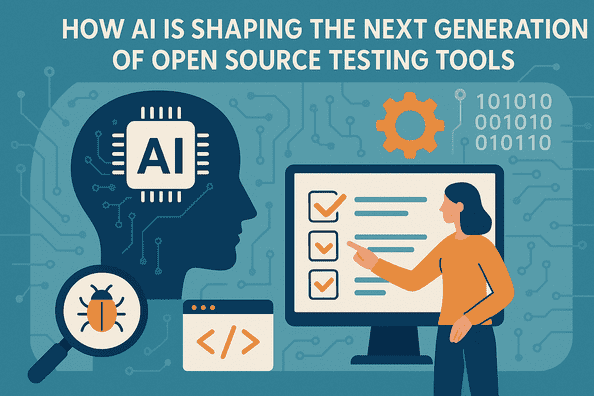The software testing landscape is evolving rapidly. Traditional testing methods often require extensive manual effort, repeated test execution, and careful maintenance of test scripts. While open source testing tools have offered flexibility, cost-effectiveness, and community-driven innovation, integrating artificial intelligence (AI) is now taking them to the next level.
AI is no longer just a futuristic concept—it is actively transforming how QA teams design, execute, and maintain tests. By combining AI capabilities with open source testing tools, teams can automate repetitive tasks, predict defect-prone areas, and improve test coverage without writing countless manual scripts. In this article, we explore how AI is shaping the next generation of open source testing tools and what it means for QA in 2026.
The Role of AI in Modern Testing
Artificial intelligence brings several capabilities that enhance the effectiveness of software testing:
Intelligent Test Generation: AI can automatically generate test cases based on code analysis, user behavior, or API traffic.
Test Maintenance Automation: Machine learning algorithms can identify obsolete or failing tests and suggest updates.
Defect Prediction: AI models analyze historical data to predict areas of code likely to contain bugs.
Test Prioritization: By learning from past test results, AI can prioritize tests with the highest likelihood of detecting defects.
Visual Testing: AI can detect UI anomalies, layout inconsistencies, or visual regressions without human intervention.
When applied to open source testing tools, these capabilities significantly reduce manual effort while improving software quality and speed of delivery.
How AI Is Enhancing Open Source Testing Tools?
Several open source testing tools are integrating AI to improve testing efficiency and reliability. Here are some ways AI is shaping the next generation:
1. AI-Powered Test Generation
Tools like Keploy use AI to automatically record real API traffic and generate test cases. This eliminates the need for manually writing repetitive tests and ensures higher test coverage across different scenarios.
Other AI-assisted open source frameworks analyze code paths or user interactions to create relevant tests automatically, making regression testing faster and more efficient.
2. Intelligent Flakiness Detection
Flaky tests are a common challenge in automation, causing false positives and wasting developer time. AI-enhanced open source tools can analyze test execution patterns, detect flakiness, and suggest fixes. This ensures CI/CD pipelines run reliably without unnecessary build failures.
3. Predictive Test Analytics
AI models can predict which parts of an application are more prone to defects based on historical test results, code changes, and past bug reports. Open source tools are beginning to integrate predictive analytics dashboards, allowing QA teams to focus on high-risk areas and optimize their test suites.
4. Automated Regression Testing
Regression testing is time-consuming, especially for large applications. AI helps identify which tests are essential for a given change, automating execution and ensuring critical functionality remains stable without running the full test suite unnecessarily.
5. Visual and UI Testing
AI-powered visual testing can detect subtle UI changes or layout issues that traditional automated tests may miss. Open source tools integrated with AI can compare screenshots, identify anomalies, and report visual regressions efficiently.
Benefits of AI in Open Source Testing Tools
Integrating AI with open source testing tools brings multiple benefits for QA teams:
Reduced Manual Effort: Automated test generation and maintenance minimize repetitive work.
Improved Test Coverage: AI ensures tests cover edge cases and critical paths that humans may overlook.
Faster Feedback: AI prioritizes high-risk tests in CI/CD pipelines, accelerating the release process.
Cost Efficiency: Leveraging open source tools with AI avoids expensive licensing while providing advanced capabilities.
Continuous Improvement: Machine learning models improve over time, making test suites smarter and more reliable with each iteration.
Examples of AI-Enabled Open Source Testing Tools
Keploy – AI-based API test generation, automatically capturing real traffic and converting it into maintainable test cases.
Test.ai (Open Source Components) – AI-driven visual testing and regression detection for mobile and web applications.
Mabl (with community integrations) – Offers machine learning algorithms for self-healing automated tests in open source pipelines.
Selenium with AI Plugins – Enhances traditional Selenium tests with AI for dynamic element detection and anomaly identification.
These tools demonstrate the growing synergy between AI and open source testing, making QA more efficient and intelligent.
Best Practices for Adopting AI in Open Source Testing
To maximize the benefits of AI in testing:
Start with critical test areas: Focus AI-assisted testing on high-risk components or frequently changing modules.
Integrate with CI/CD pipelines: Ensure AI-powered tests run automatically with every build and provide actionable insights.
Monitor AI predictions: Regularly validate AI-generated tests to avoid false positives or missed defects.
Combine AI with human expertise: AI enhances testing, but human judgment is still critical for exploratory and complex scenarios.
Leverage community and updates: Open source AI testing tools evolve rapidly; stay updated with the latest features and best practices.
The Future of AI in Open Source Testing
By 2026, AI-driven open source testing tools will become the norm rather than the exception. Teams can expect:
Self-maintaining test suites that adapt to code changes automatically.
Smarter regression testing with predictive analytics and flakiness detection.
Integration of AI across functional, performance, and security testing.
Enhanced observability and dashboards, providing actionable insights for both QA and development teams.
The combination of AI and open source testing tools promises a future where QA is faster, more reliable, and more intelligent—enabling teams to deliver high-quality software at unprecedented speed.
Conclusion
AI is reshaping the open source testing landscape, making automation smarter, tests more reliable, and QA processes more efficient. By integrating AI with open source testing tools, organizations can reduce manual effort, enhance test coverage, and accelerate CI/CD pipelines without incurring high costs.
The next generation of open source testing tools powered by AI is set to redefine software quality assurance, empowering teams to catch more defects earlier, optimize testing workflows, and build software with greater confidence.



